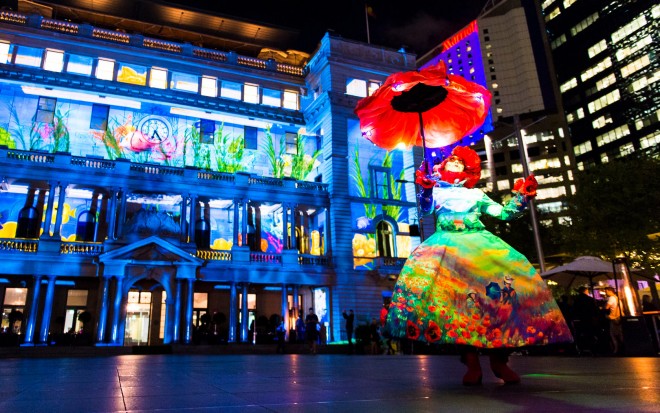Making Vivid Happen: Behind The Scenes At The World’s Largest Outdoor Gallery
3500 people, dozens of teams, 13 precincts, and an almost unbroken chain of art and entertainment. Vivid Sydney is more than just a pretty face.


Inspired By Intel
Together with Intel Australia, we’re exploring Vivid Sydney 2015.
–
Vivid is a big, shiny, immersive event, unprecedented in Australia in terms of its scope, its appeal and its visibility, both literally and through the immense reach of social media. Which means trying to explain how it works is like trying to expose the magic behind the wizard behind the illusion.
How do you pull back the curtain on the most public event the city’s ever seen, the performance of which everyone can see happening, right now, in real time?
If there were such a wizard, his name would be Ignatius Jones: Creative Director of Vivid Sydney, infectiously enthusiastic patron of the arts, and great suspender of disbelief. Just days before the momentous Lights On moment, the Friday night official opening of Vivid when the big red button gets pushed, I pressed him for some insight into how it’s done, and what it must feel like.
Jones compares the process to an epic Cecil B. Demille production. It starts with a small group of directors with an idea, and it ends with about 3500 people, many of whom are specialists working in dozens of teams, doing jobs like operating a giant projector, attending to guests, or coding 3D animations. “And we’re now stretched out across 14 precincts — so when the time comes to press the button, it’s the equivalent of the parting of the Red Sea.”
In the final days before launch, the operation is less manic than you would imagine. Seven years into a festival of art, light and music, around 90% of the organisers and staff have done it before; the crew is a regimented corps holding it together on the ground, while punters (numbering 1.5 million in total last year) bask unaware in the glow of a citywide amusement park.
The strategy of keeping the crowds engaged is as intricate as the installations themselves. The experience is designed to create a path of immersion through the city, like walking through an exhibition in a modern art gallery; though it feels spontaneous as you wander through a precinct, it’s anything but. “We call the strategy ‘beacons and breadcrumbs’,” says Jones. A beacon is something major that can be seen from a distance, like the Opera House or the projections on Customs House, which people gravitate towards. There’s a breadcrumb every 50 meters that’s designed for people to interact with for a few minutes — and while they wait their turn, they can watch others play.
“You want to keep them entertained along the way, because the best way to control a crowd is to entertain it,” he says. “The chain of entertainment is almost like nuclear fission: it just keeps rolling along. The way we designed it is that eventually you will be able to start Vivid at the Opera House and walk right along Sydney’s foreshore all the way to The Star, and be totally entertained. There’s one piece missing from that, which is Barangaroo, and that’ll be on board next year.”
The Sum Of Too Many Parts To Count
Making the final product of Vivid even more complex, its output is crowd-sourced through an expression-of-interest process. “We invite light artists from around the world – and people who might become light artists, or have ideas for installations – to send us their applications,” says Jones. From there, he, Anthony Bastic (Curator of Vivid Light), and Rodney Cambridge (Project Director of Vivid Sydney) go through some 300 expressions of interest and formulate a program that conforms to the festival’s overarching themes: and innovation through ideas and technology.
The Vivid team develops each project with its artist – whether it’s an independent designer, a student or a company – from CAD plans to prototypes to the final bump-in, which sometimes barely resembles the original pitch. No one’s entirely sure if the installations will work as planned until Lights On, since most are new to the often-experimental technologies being used. “Because we take to the crowdsourcing strategy, we tend to get the latest technology first,” says Jones. “And not only from the big companies, but often from young students and universities coming to us with cross-faculty projects.”
Chris Knapp, one of the designers of Arclight at The Rocks, details the nine-month journey from one idea to a working, 3D, 1:5 scale prototype, to those anxious final moments before Lights On. Leading up to Vivid is “like trying to ride a minor tornado – but in a good way,” says Knapp. “You can have a clear plan for most of the installation, but you have to be prepared to deal with the unpredictable, like rain delays or parts turning up late. You need to keep on your toes and adapt to manage the unexpected. After all, you are exhibiting the installation for the first time in the most public of circumstances.”
The installation represents a tangle of native Australian mangroves, programmed to respond to their environment in a process that resembles bioluminosity. Knapp, a designer at Studio Workshop, collaborated with colleague Jonathan Nelson as well as academics and students from Bond University, UNSW, Matsys Design and California College — and German engineering firm Bollinger + Grohmann. “Setting up before the festival is intense every day. It means an early start and a late finish … The development of the plastic structures took place as a team of academics and staff with prototyping and testing in a fluid way,” Knapp explains. “We’d then Skype with our engineer in Melbourne and counterparts at UNSW who did the lighting. The 3D modelling allowed contributors to work together regardless of their location.”
The Power Of Interactivity
Interactivity is always part of Vivid, but mass-participation gaming is one of this year’s overarching themes, with existing methods being used in new ways and on a massive scale. “Imagine taking the Kinect sensor from an Xbox, which can accommodate three or four people, but then using six of them,” says Jones. “So, you can pick up 30 people, all of whom are interacting with an electronic game that’s being projected on a wall that’s 50 feet high.”
A lot of these opportunities come courtesy of Intel, Vivid Lights’ major sponsor and a content partner with Junkee. Transcendence at Martin Place is a futuristic hub, where visitors can fly a swarm of drones at Game of Drones, or experience the movement on their faces and bodies projected onto a 3D avatar. According to Jones, Intel’s Real Sense technology blows the interactive cameras we are used to out of the water. “While Kinect uses one depth camera, Real Sense uses a depth camera, a 4-colour HD camera and an infrared camera all combined, so it can do things like recognise faces and respond to movement. It can pick up your head and put it onto an avatar that you can then control.”
Dozens of Intel Galileo gen 2 development boards – computer chips made to program digital devices and electronic objects – allow for an unprecedented level of crowd interaction. A drumming circle triggers a forest of lights at Martin Place; the electric neurons of a giant brain at Circular Quay respond with light and sound when touched; the Arclight mangroves at The Rocks and 6000 searchlights are controlled with the waving of arms outside The Star. “The great opportunity with Intel is that they’re also an organisation that really celebrates creativity and technology,” says Bastic, Vivid’s Program Director. “So we’ve been able to allow artists to experiment with Galileo boards, making the artworks function in a way that’s a lot more innovative.”
Vivid is about not just innovation, but sustaining a mass sense of wonder. Even when the illusion is powered by a computer chip and we know how it works, there’s nothing that can explain away the awe of a city of light. “We call it the world’s largest outdoor art gallery, but it’s more than that,” says Jones. “In an art gallery you’re supposed to have this weird sense of awe and respect, which I think alienates people. To many people, interactivity is just the new black. To us, it’s about people engaging with art and letting art do what it’s meant to do: change lives, increase understanding, communicate, enthuse – all of the great things that a good piece of art can do.”
–
Dijana Kumurdian works in digital creative at Present Company. She writes freelance and does web design on occasion, and DJs under the name Matka at dank discos around Sydney.
Feature Image by Patrick Stevenson.





